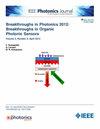Micromachining Error Tolerance Analysis in EEG Sensing Nanostructure Arrays: Control of Fano Resonance for Enhanced Performance
IF 2.4
4区 工程技术
Q3 ENGINEERING, ELECTRICAL & ELECTRONIC
引用次数: 0
Abstract
The silicon-based electroencephalography (EEG) sensing technology encounters performance limitations due to spectral distortions caused by micromachining, which significantly degrade its effectiveness in Brain-Computer Interface (BCI) systems. To enhance the performance of EEG sensors, this study systematically investigates the tolerance of micromachining errors in silicon-based nanostructured arrays, specifically focusing on photonic crystal nanobeam cavities (PCNCs) used in optical EEG sensing systems. We propose a comprehensive error control methodology that integrates finite-difference time-domain (FDTD) simulations with multivariate linear regression (MLR) analysis to quantitatively assess the impact of lithographic and alignment errors on Fano resonance spectral characteristics. Our analysis establishes critical tolerance boundaries: horizontal displacement errors must be maintained within −4.56 nm to +26.31 nm, and angular deviations should be constrained between −0.068° and +0.083°. By establishing precise tolerance boundaries, our approach effectively mitigates spectral distortion while enhancing production yield, thereby ensuring manufacturing consistency. Notably, this study aligns with the fundamental objective of precision allocation in conventional silicon nanocomponents: achieving target performance metrics with cost efficiency.脑电传感纳米结构阵列微加工容差分析:Fano共振控制增强性能
硅基脑电图(EEG)传感技术由于微加工引起的频谱畸变而受到性能限制,严重降低了其在脑机接口(BCI)系统中的有效性。为了提高脑电传感器的性能,本研究系统地研究了硅基纳米结构阵列的微加工误差容忍度,特别关注了光学脑电传感系统中使用的光子晶体纳米束腔(PCNCs)。我们提出了一种综合误差控制方法,将时域有限差分(FDTD)模拟与多元线性回归(MLR)分析相结合,定量评估光刻和对准误差对法诺共振光谱特性的影响。我们的分析建立了临界公差边界:水平位移误差必须保持在- 4.56 nm到+26.31 nm之间,角偏差应限制在- 0.068°到+0.083°之间。通过建立精确的公差边界,我们的方法有效地减轻了光谱失真,同时提高了产量,从而确保了制造的一致性。值得注意的是,本研究符合传统硅纳米组件精确分配的基本目标:以成本效率实现目标性能指标。
本文章由计算机程序翻译,如有差异,请以英文原文为准。
求助全文
约1分钟内获得全文
求助全文
来源期刊

IEEE Photonics Journal
ENGINEERING, ELECTRICAL & ELECTRONIC-OPTICS
CiteScore
4.50
自引率
8.30%
发文量
489
审稿时长
1.4 months
期刊介绍:
Breakthroughs in the generation of light and in its control and utilization have given rise to the field of Photonics, a rapidly expanding area of science and technology with major technological and economic impact. Photonics integrates quantum electronics and optics to accelerate progress in the generation of novel photon sources and in their utilization in emerging applications at the micro and nano scales spanning from the far-infrared/THz to the x-ray region of the electromagnetic spectrum. IEEE Photonics Journal is an online-only journal dedicated to the rapid disclosure of top-quality peer-reviewed research at the forefront of all areas of photonics. Contributions addressing issues ranging from fundamental understanding to emerging technologies and applications are within the scope of the Journal. The Journal includes topics in: Photon sources from far infrared to X-rays, Photonics materials and engineered photonic structures, Integrated optics and optoelectronic, Ultrafast, attosecond, high field and short wavelength photonics, Biophotonics, including DNA photonics, Nanophotonics, Magnetophotonics, Fundamentals of light propagation and interaction; nonlinear effects, Optical data storage, Fiber optics and optical communications devices, systems, and technologies, Micro Opto Electro Mechanical Systems (MOEMS), Microwave photonics, Optical Sensors.
 求助内容:
求助内容: 应助结果提醒方式:
应助结果提醒方式:


